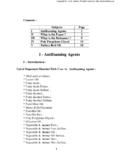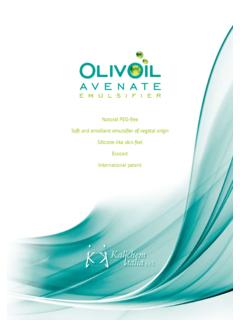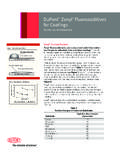Transcription of ELAISSCH26 - SurfaTech
1 Elaissari_4304-0_Ch26_R1_04-16-03 08:44:09261 Preparation and Applications of2 silicone Emulsions Using Biopolymers3 MUXIN LIU, AMRO RAGHEB, PAUL ZELISKO, and4 MICHAEL A. BROOKMcMaster University, Hamilton, Ontario, Canada5I. INTRODUCTION6A. Fundamentals7 Dispersions of water in oil, or the inverse, are inherently unstable. Emulsifica-8tion is thus a nonequilibrium process such that the average droplet size in an9emulsion tends to increase over time. However, the characteristic time scales10for coarsening of emulsions can span a remarkably wide range, from seconds to11several years, that depends on the nature of the oil, the surfactants used to12stabilize the emulsion, and the processing history.
2 It is fair to say that not all13the parameters affecting emulsion stability are completely understood. Current14practices in emulsion formulation thus combine art with science. With silicones,15being specialty materials and very unlike their organic counterparts, both theory16and art are less well explored than organic silicone Properties18 Silicones possess very unusual properties by organic standards. For example, the19low torsional force constant of the Si-O-Si-O linkage [1] results in exceptionally20flexible molecules: simple dimethylsilicone polymers [polydimethylsiloxane,121 PDMS (Me2 SiO)n,Scheme 1] haveTgvalues of approximately 123 Cirrespec-22tive of molecular weight over a range of 1000 1,000,000 [2].
3 This backbone23flexibility, in combination with the high hydrophobicity of thegem-dimethyl24groups and relatively high ionic character of the Si-O linkage, results in excep-25tional surface properties for silicone polymers [3]. These properties are greatly26amplified when either nonpolar or polar functional groups are added to the sili-27cone, creating true surfactants [4]. Depending on structure, silicones can be used28as wetting agents, for foaming or defoaming applications, as lubricants, and,29747SC118 Elaissari_4304-0_Ch26_R1_04-16-03 08:44:09748 Liv et 1perhaps most important of all, as compounds that render liquid/air or solid/air1surfaces hydrophobic: the methyl groups extend into the air at the interface2generating very low-energy surfaces [3].
4 The surface tension of silicones is a3function of molecular weight, increasing from about 16 mN/m for Me3 SiO-4(Me2 SiO)nSiMe3,n=0, to 20 21 mN/m for medium and high molecular weight5silicones,n>10 [5].6 PDMS is not compatible with aqueous media. If the molecular weight of a7given PDMS is high enough, typically starting at six to eight Me2 SiO units,8 PDMS is also incompatible with mineral oils or more polar oils ( , ester oils,9natural fats or oils). These hydrophobic and oleophobic properties make it very10difficult to form emulsions between silicones and aqueous solutions or organic11oils, though high shear can lead temporarily to emulsions that break down easily12and rapidly [6].
5 13C. Use and Interest in silicone Emulsions14 With the appropriate surfactant(s), silicones can be formulated into emulsions15of a variety of types including w/o, o/w, o/w/o, w/o/w, etc. (W, water; O, oil;16the oil may additionally be silicone oil or organic oil). The specific morphology17of the emulsion depends on the surfactants used and the processing 08:44:09749 silicone EmulsionsSilicone emulsions can also arise inadvertently, as a consequence of adventitious1surfactants, particularly in biological environments, as shall be discussed Impact of silicone Emulsions in Biological3 Domains.
6 Purpose of this Chapter4In this chapter, we shall outline some of the basic parameters associated with5the formation of colloidal silicone dispersions and then provide some examples6of typical silicone emulsions and their application. The remainder of the review7will focus on silicone emulsions that form in contact with biological , we shall describe emulsions that spontaneously form in contact with9the inner eyeball following retinal repair surgery. Finally, the utilization of pro-10teins and atypical functional silicones to prepare water/ silicone emulsions will11be described.
7 Both the features necessary for a stable emulsion and the conse-12quences on protein/enzyme tertiary structure will be FUNDAMENTALS OF silicone EMULSIONS14A. Classes of silicone Emulsifiers15 Awide variety of surfactants has been used to emulsify and stabilize water/16silicone emulsions. As early as 1958, Sato [7] examined the use of many con-17ventional surfactants, including fatty acid esters of polyethylene glycol (non-18ionic), quaternary ammonium salts (cationic), and alkyl sulfates or alkylarene-19sulfonates (anionic) to stabilize poly(organoalkylsiloxane) emulsions.
8 It was20demonstrated that conventional surfactants based on hydrocarbon chains are21generally not very efficient surfactants for silicone emulsions, although sodium22dodecyl sulfate (SDS) is useful as a probe for examining the stability of silicone23emulsions [6]. The adsorption of the alkyl groups at the silicone interface is not24as strong as at an oil interface. In spite of this, because of their relatively low25cost, these surfactants are commonly used in commercial emulsions (see discus-26sion of oil-in-water emulsions below). More efficient, but more expensive, sili-27cone-based surfactants were developed both as emulsifiers and stabilizers for28silicone emulsions, particularly water-in-oil emulsions [4].
9 The most common29silicone surfactants are described Types of Surfactants31 Although a variety of phenyl- and trifluoropropyl-modified silicones are sold32commercially, there has been little investigation of surfactants based on these33compounds. The vast majority of research has focused on modified dimethylsili-34cones. A wide variety of hydrophils have been combined with silicones to make35viable surfactants, including ionic groups such as sulfonates [8], sulfosuccinates36 Elaissari_4304-0_Ch26_R1_04-16-03 08:44:09750 Liv et al.[9], phosphates [10], thiosulfates [11], betaines [12], sulfobetaines [13], and1quaternary ammonium salts [14].
10 The two major classes of silicone -based sur-2factants are based on amines or polyethers, with the latter holding the lion s3share of commercial emulsifiers involve linear oligomeric or polymeric silicone5molecules modified with hydrophilic and, optionally, hydrophobic linear block (AB and ABA) and comblike structures are known. In the7linear surfactants, functional groups can be located only at the ends of the struc-8tures. By contrast, the distribution of functional groups in comb structures is9ruled by statistics (Scheme 1).101. Polyethers11 The most important class of emulsifiers for silicones is based on poly(ethylene oxide) and mixed poly(ethylene oxide)/poly(propylene ox-13ide) polar blocks may be grafted to the silicone backbone (Scheme 1).








